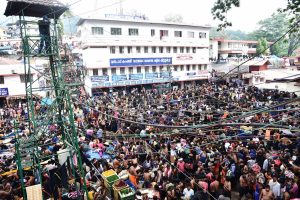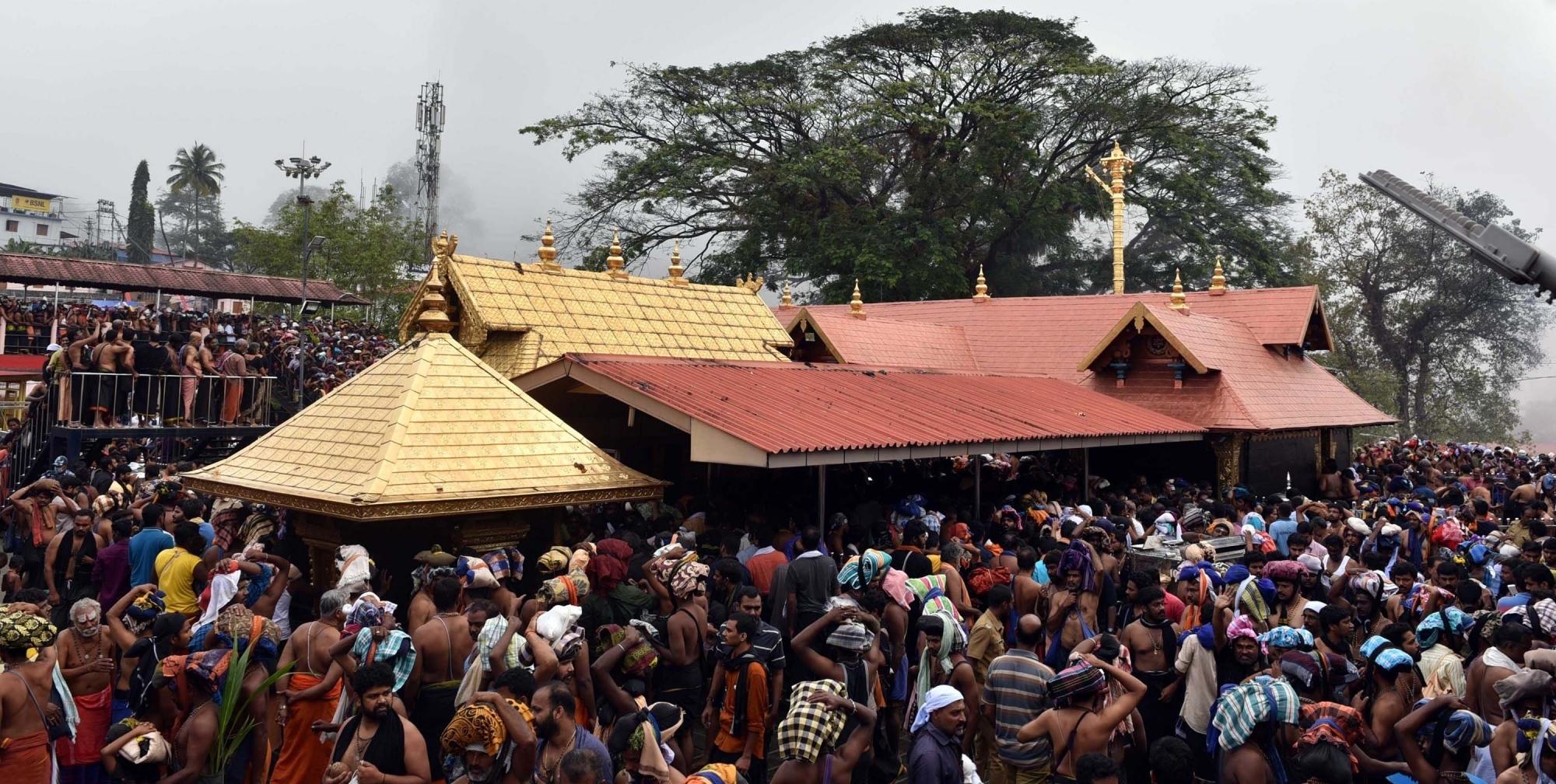What does the exclusion of women from Sabarimala say about their status in the country when the state, religion and community give overt sanction to this denial of their rights, and the high court too upholds this discrimination?
By Charmy Harikrishnan
Eighty years after the ‘backward castes’ of Kerala – who were barred from entering shrines and banished even from roads leading to them – struggled and won the right to enter temples, it is time for a second temple entry movement in the state. For women of all ages to chant Swamiye Saranam Ayyappa, climb the hill and enter the Sabarimala temple. As the Supreme Court takes up the issue on February 8, the question it must decide is whether brazen misogyny can supersede rights protected by the constitution. As men and women who claim to be “true” believers insist that rituals be honoured even if they exclude women, the question before the court, and the whole of society, is simple: Should the gods reflect our basest instincts or our noblest aspirations?
Chief Minister Oommen Chandy, whose own position has become untenable in the wake of allegations of corruption and obstruction of justice, has already said that his government would not interfere on issues of “customs and beliefs” and that this would be conveyed to the apex court. The day before Chandy made his statement, the government-controlled Travancore Devaswom Board, which manages the temple along with several others, said that it is part of the temple tradition to bar the entry of women between the ages of 10 and 50, roughly, the ages of menarche and menopause. This means that women who could possibly menstruate cannot enter the shrine of Ayyappa where millions of men, age and religion no bar, come to pray every year.
The myth of ‘time immemorial’
The Kerala high court (in S. Mahendran vs Secretary, Travancore Devaswom Board) also upheld traditions in its judgment on Sabarimala in 1991:
“The restriction imposed on women aged above 10 and below 50 from trekking the holy hills of Sabarimala and offering worship at Sabarimala Shrine is in accordance with the usage prevalent from time immemorial.”
This raises a few questions. What did the court mean by “time immemorial”? Do we allow traditions of the past, however arbitrary, prejudiced and discriminatory these may be, to bear upon the present? Do we allow thantris (priests) and devaprasnam (a curious astrological practice in Kerala to divine god’s will) to bar the freedoms of citizens, or do we follow the constitution that allows everyone the freedom to practise religion? Everyone. There is no clause anywhere that says, “except women, who are likely to bleed this or the next month, in Sabarimala”.
The court said “time immemorial”. We should be careful with such words. Look at the origin stories. Lord Ayyappa, the legend goes, is Hariharasuthan, born of the union of Vishnu in the form of the beautiful woman Mohini and Shiva. This has been read as an epic moment for fluid gender identity and homosexual union. But as experts like Bibek Debroy point out, there is no mention of Lord Ayyappa or Sastha in any of the 18 major puranas or the epics. We have a master’s thesis at Carleton University, Canada, by Radhika Sekar, who refers to a 19th century Sanskrit text called Bhutanathopokyanam. However, there was something more interesting in her dissertation: Sekar did enter the temple during her research in 1986-87 – although she could not take the famous 18 steps, she entered the shrine through the northern entrance; although she had a darshan in the morning, she was restricted from attending an evening puja “both from a point of view of my safety and the sentiments” of the pilgrims.

The Sabarimala legend is part of stories and songs, which are passed down over the years, with accretions and deletions. If Ayyappa, as the legend goes, had a Muslim companion called Vavar, then the story emerged after the advent of Islam in 7th century AD. Meanwhile, there have been others who saw in Ayyappa an appropriation of the Buddha by the Saiva and Vaishnava traditions. The ringing call, “Swamiye Saranam Ayyappa”, recalls “Buddham Saranam Gachami” and its vow of abstinence for 41 days recalls Buddhism’s premium on celibacy. Then the story could have emerged between the 8th century – when Buddhism’s decline began in Kerala – and the 12th century.
Our past is a palimpsest. Our traditions are layered and our stories multiple. Which is why when one narrative is chosen as the authorised version, it becomes problematic and should be contested especially when it furthers prejudices, misogyny and discrimination, when it tosses aside women as “polluted” creatures who should not be allowed in front of the lord.
Traditions, rotten and invented
We should be careful when we talk about honouring traditions, steeped as they have been in medieval darkness and discrimination. Here are some “immemorial” traditions that were done away with: women in Kerala could not cover their breasts until 1865, avarna children would not be admitted to government schools until the beginning of 20th century, and lower castes could not enter a temple until 1936. It was only recently that another of Sabarimala’s glorious traditions – the “divine” Makaravilakku hovering in the horizon on January 14, for which millions of pilgrims congregated at the temple – was debunked as the secret handiwork of humans.
If Radhika Sekar could enter the shrine about four years before the high court order, we can safely assume that the wink-wink arbitrary permission given to women became a rigid code banning them from Sabarimala only recently – in fact with the high court judgement just 25 years ago. The 1991 case was filed after the then Devaswom commissioner, J. Chandrika conducted the annaprasan of her grandchild at Sabarimala in the presence of other women. The Devaswom Board, which then defended the presence of the women at the temple, said women were allowed on the first five days of every month but not during the festival season of November-January. The queen of Travancore is also reported to have visited the temple in 1940 when she might have been just 45.
Now the argument is that women between the age of 10 and 50 cannot keep the 41-day vow because they will become polluted when they have their period. It is interesting how sanitised even that high court judgment is: there is not even one mention of the word “menstruation”. Instead, it says: “Women of the age group 10 to 50 will not be in a position to observe vratham continuously for a period of 41 days due to physiological reasons.”
This has become a stick to beat women with, to publicly shame women. The head of the Travancore Devaswom Board, Prayar Gopalakrishnan, had the temerity to say that women will not be allowed in as long as there is no device to measure their “menstrual purity”. Does he have a device to measure the purity of men and tag their bodily fluids? Does he stand at the sanctum sanctorum to check if the men have sneezed or salivated, urinated or masturbated or had wet dreams?
Protecting the lord, or patriarchy?
The other “reason” that is given in and out of court is that Ayyappa is a brahmachari and should be protected from the sight of women. Let us not foist our basest urges on Ayyappa and turn him into this young man who will be tempted at the sight of a woman. Let us not reduce woman into a temptress of man and god, as if she has nothing better to do. If you need a myth to counter your myth, here is one. The woman who loves Ayyappa, Maalikapurathamma, is next-door, waiting for the day he would marry her. If he can resist her charms, then he can surely manage hordes of women in black who only seek a few random blessings.
There have been chants from the cosmopolitan cafes of Delhi about why women in Kerala should fight for entry into a temple when they should be fighting for equality at homes and in offices. The fight is at all levels and the battle cry will be the loudest if the state decides to sanction sexism. I am in Thiruvananthapuram now, startled by the fact that I am living in the midst of a community that vehemently denies women entry into a temple. By giving access, you are giving a signal, you are saying “No” to a pernicious mindset that believes women and men are not equal.
I will keep an irumudi (a double knot that every pilgrim carries on the head) ready. The Supreme Court has to let me climb the hill and say “Swamiye Saranam Ayyappa” at the Sabarimala temple.
This article was originally published on The Wire on 05/FEB/2016
Follow Charmy Harikrishnan on Twitter: @charmyh





Be First to Comment